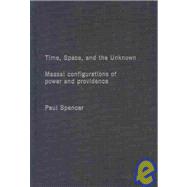
Note: Supplemental materials are not guaranteed with Rental or Used book purchases.
Purchase Benefits
Looking to rent a book? Rent Time, Space and the Unknown: Maasai Configurations of Power and Providence [ISBN: 9780415317245] for the semester, quarter, and short term or search our site for other textbooks by Spencer; Paul. Renting a textbook can save you up to 90% from the cost of buying.
| List of illustrations | x | ||||
| Preface | xii | ||||
| Note on orthography | xv | ||||
| 1 Introduction | 1 | (12) | |||
| PART I The boundaries of time, space, and certainty | 13 | (132) | |||
|
15 | (28) | |||
|
15 | (3) | |||
|
18 | (5) | |||
|
23 | (6) | |||
|
29 | (3) | |||
|
32 | (3) | |||
|
35 | (2) | |||
|
37 | (6) | |||
|
43 | (24) | |||
|
43 | (7) | |||
|
50 | (5) | |||
|
55 | (3) | |||
|
58 | (4) | |||
|
62 | (1) | |||
|
63 | (4) | |||
|
67 | (31) | |||
|
68 | (3) | |||
|
71 | (4) | |||
|
75 | (2) | |||
|
77 | (1) | |||
|
78 | (3) | |||
|
81 | (2) | |||
|
83 | (2) | |||
|
85 | (3) | |||
|
88 | (3) | |||
|
91 | (7) | |||
|
98 | (26) | |||
|
98 | (4) | |||
|
102 | (2) | |||
|
104 | (2) | |||
|
106 | (6) | |||
|
112 | (3) | |||
|
115 | (4) | |||
|
119 | (5) | |||
|
124 | (21) | |||
|
126 | (8) | |||
|
134 | (8) | |||
|
142 | (3) | |||
| PART II Diverging models in space and variation over time | 145 | (127) | |||
|
147 | (33) | |||
|
147 | (3) | |||
|
150 | (6) | |||
|
156 | (5) | |||
|
161 | (8) | |||
|
169 | (6) | |||
|
175 | (5) | |||
|
180 | (25) | |||
|
181 | (5) | |||
|
186 | (2) | |||
|
188 | (2) | |||
|
190 | (4) | |||
|
194 | (3) | |||
|
197 | (8) | |||
|
205 | (29) | |||
|
205 | (1) | |||
|
206 | (5) | |||
|
211 | (1) | |||
|
212 | (4) | |||
|
216 | (2) | |||
|
218 | (6) | |||
|
224 | (10) | |||
|
234 | (14) | |||
|
235 | (3) | |||
|
238 | (4) | |||
|
242 | (2) | |||
|
244 | (4) | |||
|
248 | (24) | |||
|
248 | (2) | |||
|
250 | (4) | |||
|
254 | (3) | |||
|
257 | (5) | |||
|
262 | (2) | |||
|
264 | (3) | |||
|
267 | (5) | |||
| References | 272 | (7) | |||
| Subject index | 279 | (7) | |||
| Name index | 286 |
The New copy of this book will include any supplemental materials advertised. Please check the title of the book to determine if it should include any access cards, study guides, lab manuals, CDs, etc.
The Used, Rental and eBook copies of this book are not guaranteed to include any supplemental materials. Typically, only the book itself is included. This is true even if the title states it includes any access cards, study guides, lab manuals, CDs, etc.